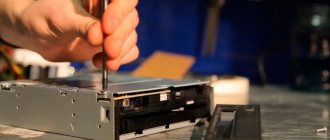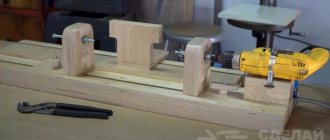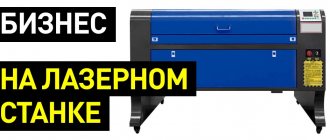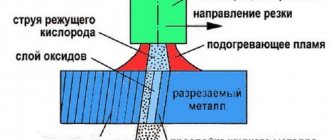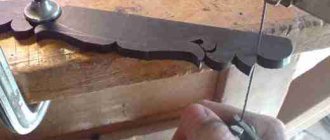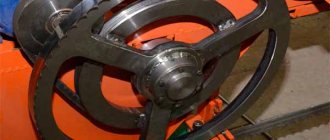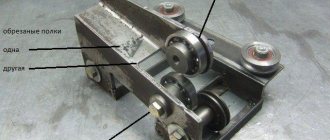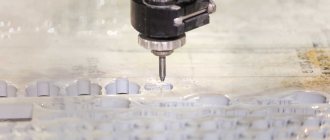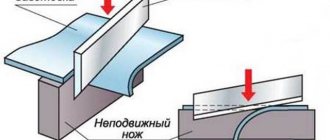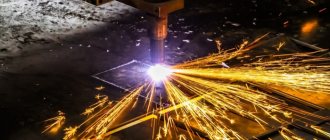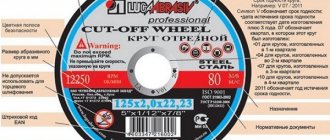What laser is needed to cut plywood?
Laser cutting works on the principle of burning the material with a directed, concentrated light beam of high power. The main disadvantages of this non-contact method: smooth edges, the ability to obtain complex shapes and workpieces of different sizes, high cutting accuracy, ease of control. Among the disadvantages are the darkening of the work area and the high price of the equipment. The photo shows one of the machine models.
The following machines differ in their functionality:
- Cutting and engraving machine. It has low power and is designed for cutting thin plywood and engraving.
- Industrial (professional) laser machine. It is capable of cutting large sheets of any thickness. It has a larger workbench, a reinforced body, larger dimensions and increased power. Accordingly, the cost of the machine is higher.
- Small-sized desktop laser cutters. They can be used at home, have a table no more than 1 m wide, less power and an affordable price.
- Universal milling machines. They are capable of not only cutting material, but also carrying out milling work.
Depending on the type of control, the following options are distinguished:
- Manually operated machines. This is standard equipment with an electric drive, which is controlled manually by the worker.
- CNC machines. They have software and are controlled via a computer. It is enough to enter the required program, and the machine will automatically cut the sheet or engrave it exactly as specified.
Main parameters to consider when choosing a machine:
- Desk dimensions. They determine the dimensions of the plywood sheets to be processed. For domestic purposes, the minimum working field is 30 × 40 cm, and for commercial purposes, at least 60 × 90 cm should be chosen.
- Output power. The depth of penetration of the beam, and therefore the thickness of the sheet being cut, depends on it. For plywood 1 mm thick you need at least 40 W.
- Desktop progress. The height of its lowering is important for installing additional accessories. It is recommended to be at least 15–20 cm.
- Laser tube power. The cutting speed of the sheet depends on it. For a productive machine, it is desirable to have about 8–100 W.
In addition to these parameters, the cutting accuracy (deviation), dimensions and weight of the machine should be taken into account.
Specifics of wood laser processing
Working with wood is difficult, since it is a heterogeneous, living material consisting of individual fibers. Each type of wood has its own characteristics and characteristics. Processing such material has always required a lot of time, skills and depended on the experience of the master. The percentage of defects and waste was quite high; each product turned out to be unique, since it was almost impossible to make them exactly the same size with exactly matching elements.
Thanks to the use of CNC machines, it has become possible to take wood cutting to a whole new level:
- The laser does not cut, but burns through the wood, there are no chips or nicks on it, the edges are perfectly smooth.
- You can control the depth of the cut, thereby burning or cutting out the desired contours.
- The operation of the machine is controlled by a computer program, which is based on a drawing or drawing made in a graphics editor. The image created by the designer or engineer is transferred to the tree without distortion, while maintaining the specified dimensions.
- Performing one operation is possible any number of times, thereby creating batches of absolutely identical products.
- The speed of manufacturing a part on a laser cutting machine is higher than with any other wood processing method. Productivity also increases due to the absence of the need to process edges.
To produce high-quality products, highly qualified craftsmen are required. To avoid deformation of the wood, prevent edges from burning, and make a clear design when engraving, it is necessary to correctly select the speed, order and operating mode of the laser.
LASERCUT is ready to provide assistance at any stage. Choose a machine for laser cutting of wood. Deliver, launch and commission equipment. Train employees to operate CNC machines. You can learn more about laser cutting of wood on the company’s YouTube channel.
Laser head for cutting plywood
The laser head of a machine is a device that includes the laser radiation source itself and an optical system for focusing the beam. The following varieties are distinguished:
- Gas or CO2. It operates on gas mixtures. The luminous flux is enhanced as a result of vibration during transitions in carbon dioxide molecules during the passage of light. The wavelength is 10.6 µm. The CO2 laser head is most commonly used in factory cutting machines.
- Fiber. In it, the active medium and resonator are made of optical fibers. Such lasers have increased power with small dimensions. They are used for cutting refractory materials and are not economically feasible for plywood, and therefore are rarely used.
- Solid state or semiconductor. A special semiconductor material in a solid state is used as the active medium. Lasers are expensive and are not used for cutting wood or plywood sheets. They are installed in universal machines capable of processing metals.
- Diode. This is a semiconductor laser based on an LED. The laser beam is formed due to inversion in the pn junction zone during the passage of light. Such a device is widely used in various electronic systems. Their power is low, but quite sufficient for cutting plywood. This source is most often used in homemade machines.
Thus, for cutting plywood, heads based on a CO2 laser are considered the best option. Homemade heads use LEDs from various devices (printers, players, laser pointers, etc.).
Operating principle and types of devices
The working element of the device is a laser beam , that is, a powerful light beam. When it comes into contact with the surface of the plywood, the place of contact is subjected to strong heating, and the wood fibers simply burn out. This is how non-contact laser carving occurs. Laser power depends on the equipment model and its configuration. This characteristic also determines the scope of use of the device . There are several types of devices on sale:
Desktop. Suitable for a small workshop or home, as it is designed for processing small workpieces. Power indicators - from 80 W, cost - from 40,000 rubles.- A professional machine for shaped cutting of plywood is used in the small business segment for engraving and making design elements. Power - from 200 W, cost from 160,000 rubles.
- Industrial . Laser power for cutting plywood is from 2 kW. These are full-fledged complexes with high productivity. Such equipment is used in enterprises for the production of large batches of products. Cost - from 400,000 rubles.
Laser module for cutting plywood
The main unit of a plywood cutting machine is a laser module, which includes a radiation source, optical elements, a power supply, an adjustment, control and cooling system. The modules differ according to the type of laser head. In addition, they are classified according to the type of radiation: collimated and focused. In the latter case, the beam is collected at a point. In the collimated version, you can get a line, grating, or circle. The focused version is more suitable for cutting and engraving.
Modules vary in wavelength. It can vary over a wide range - from ultraviolet to infrared zones. It is important to ensure the stability of this parameter in devices. For this purpose, high-quality devices have a thermal stabilization system for the emitter. To adjust within small limits, special mechanisms are used.
Laser power for cutting plywood
Cutting of the material is carried out due to significant heating when exposed to a concentrated light beam. The temperature must be sufficient to burn the fibers. It, in turn, depends on the energy possessed by the light flux. The energy released by the source per unit time is called the emitter power.
Laser power is considered its most important characteristic. His functional abilities depend on it. Only at a certain value the fibers begin to burn out. At the same time, as the cutting depth increases, the cutting depth also increases. So, with a small value, only surface processing is provided - engraving. To cut the material, it is necessary that the temperature be sufficient to burn out the fibers throughout the entire thickness of the sheet.
The power depends, first of all, on its type, i.e. the active medium, pumping and the presence of a resonator. The output power also depends on the optical system. Increased power is provided by fiber and solid-state lasers, but they are expensive. A less powerful but cheaper CO2 laser is quite suitable for plywood.
What laser power is needed to cut plywood?
CO2 lasers are most often used in finished machines. For cutting, the minimum power is 20–25 W. The choice of machine is made taking into account the thickness of the plywood sheet. The following selection rules are recommended for a CO2 laser:
- sheet up to 6 mm thick - 50 W;
- sheet up to 8 mm thick - 60 W;
- sheet up to 10 mm thick - 80 W.
When engraving, CO2 lasers with a power of 20–50 W are used.
Depending on the purpose, the machines have individual power adjustment limits. Desktop and household devices are available up to 80 W. In professional machines it can reach 200–250 W.
Naturally, the question arises about the possibility of using diode lasers from household appliances, which have significantly lower radiation powers. In principle, it is possible to use 2–15 W lasers of this type for cutting. The power is indicated on the model body and in the instructions.
Laser 2.1 W
The diode laser (2.1 W) is capable of cutting cardboard and plywood up to 1–1.2 mm thick. It is usually used for engraving, but it is also suitable for cutting. The greatest effect is achieved when working with paper and cardboard, which do not become carbonized after exposure to the beam.
The photo shows a finished laser module of this power - Endurance 2.1. It enables engraving on wood and plywood at speeds up to 20 mm/s. Can cut sheets 1–2 mm thick in 5–30 passes.
Laser 3.5 W
The 3.5W diode laser can cut 2-3mm thick plywood. When cutting multilayer plywood of this thickness, 20–25 passes will be required. The CNCC LaserAxe software can provide speeds of the order of 50–150 mm/min. The photo shows a box made on a machine with a 3.5 W laser.
5.6 W short throw laser
The 5.6 W laser is much faster when cutting plywood. It is capable of cutting sheets 3–5 mm thick. The Endurance 5.6 machine can operate in this mode:
- plywood 3 mm thick - up to 4 passes at speeds up to 250 mm/min;
- with a thickness of 4 mm - 8 passes at speeds up to 200 mm/min;
- with a thickness of 5 mm - 9–10 passes at speeds up to 100 mm/min.
When installing such a laser, it is recommended to use a G-2 short focal length lens.
Ultra-powerful 8W
The possibilities for cutting plywood are significantly expanded when using an 8 W device. This machine can cut sheets 4 mm thick (when installing a G-2 lens) in one pass. To cut plywood with a thickness of 6–8 mm, up to 5 passes will be required, and with a thickness of 10 mm, up to 10 passes will be required. This ensures a very suitable speed.
10W cutting laser
The 10 W module is suitable for cutting plywood up to 10 mm. In this case, sheets with a thickness of 6–7 mm are cut in 1–2 passes. Sheets 9–10 mm thick require 3–5 passes. The most popular devices are manufactured in China, providing a wavelength of 445–450 nm. The diameter of the focused spot varies from 0.1 to 10 mm. The laser module PPM-010C from MH GoPower for transmitting power over optical fiber is highly reliable.
Laser 15 W
A machine with a 15 W diode laser is approaching the optimal cutting mode. It provides cutting of sheets up to 10 mm thick in one pass, and up to 12–15 mm in 3–5 passes. A fairly reliable model 570073 is supplied from China. The wavelength is 450 nm. Focal length -18 mm.
Criterias of choice
The speed of processing sheet material depends on the power of the plywood laser cutting machine. For home use, devices with speeds from 4 to 16 m/min are suitable. Industrial machines operate much faster, but they require some skill from the master.
universal models on the market : with their help you can cut not only plywood sheets, but also other materials (metal, stone). However, the price of a “wide profile” device is much higher. And if there is no need for additional features, then spending money on unnecessary functionality is completely inappropriate.
Another important point is the control system. Operation will be greatly simplified if you choose a CNC machine. The built-in program makes it possible to quickly adjust the equipment, and all work will be done without human intervention - all you need is a digitized sketch. Such cutting equipment costs from 400,000 rubles. If your financial situation does not allow, then you can choose a manual model.
You should also pay attention to the additional components of the machine (blowing system, chiller module, and so on). Personally “upgrading” laser equipment will void your manufacturer’s warranty. That is, if the equipment suddenly breaks down, you will have to pay extra to repair it.
Nuances of laser cutting of plywood
Laser cutting has a number of features:
- When cutting, the minimum thickness of the cut is ensured, which allows for optimal cutting of the sheet with maximum accuracy.
- In the area where the beam is working, a darkening appears on the plywood. As power increases, its intensity increases. A little sanding will eliminate the defect.
- No physical effort is required during operation. The process is non-contact, eliminating the risk of deformation of thin sheets.
- The quality of the final result is influenced by the structure of the plywood. It is necessary to take into account multilayers and the presence of tree resin.
- During long-term work, the workplace must be equipped with exhaust ventilation.
- During operation, no shavings or sawdust are formed.
- Before starting work, dust must be removed from the surface of the workpiece.
- It is not recommended to use a laser when cutting varnished plywood.
When using laser modules, you should listen to these recommendations. A 2.1 W laser is quite suitable for engraving. Sheets up to 2 mm thick can be cut with a 3.5 W device, up to 3 mm thick - 5.6 W, and up to 5 mm thick - 8 W. If it is necessary to cut sheets up to 10–12 mm thick, 10–15 W modules should be used.
Lasers for cutting plywood greatly facilitate work and increase cutting accuracy. With the help of such machines you can cut out parts of any complex shape. The most important criterion for choosing equipment is the radiation power. It determines the capabilities of the machine, its productivity, and the thickness of the sheets. As it increases, the cost of the device also increases, which means that an optimal approach to selection is required, taking into account the purpose and specific conditions.
- September 21, 2020
- 14422
Advantages of crafts made from plywood using a laser machine
Beautiful and unusual plywood crafts made on a laser machine, in addition to their attractive appearance, have a number of practical advantages, which include:
- smooth edge during processing - the absence of sharp and poorly processed edges eliminates the possibility of cutting your hands or introducing a splinter under the skin;
- high cutting speed – you don’t need to spend a lot of time to make a simple plywood craft;
- price - as a rule, it is not very high, especially if the craft is made according to a standard pattern, and not according to an individual order.
Having considered a selection of ideas that can be implemented using a laser machine, the user is able to independently begin making original crafts from plywood. This material is very easy to process, and laser cutting technology makes it possible to create crafts with a variety of design solutions and unusual elements.
- 05 October 2020
- 2401
